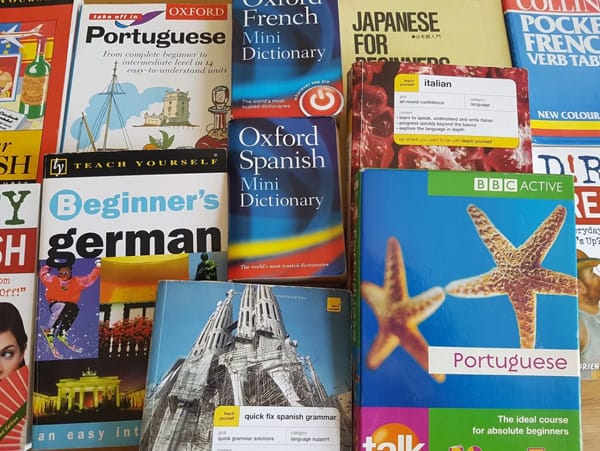What Foreign-Language Study Tells Us About Our Country
John Jackson, American Renaissance, January 16, 2020
Much has been written about the decline of civics and history in American education, but foreign language study is also in decline, particularly of European languages. As a nation of predominantly European ancestry, Americans should oppose this loss of connection to our own heritage.
Numbers released in 2018 by the Modern Language Association illustrate trends in colleges and universities. The overall rate of course enrollment in languages other than English declined from 16.5 per 100 students in 1965 to a low of 7.3 in 1980. It slowly increased to 9.1 in 2006, but declined in the following 10 years to 7.5, making the study of foreign languages less than half as popular as it was 60 years ago.
Except for Hebrew, non-Western languages have become relatively more popular than European languages. The decline in Hebrew is probably because of falling church membership and a loss of rigor at divinity schools that used to require a knowledge of Hebrew.
From 2006 to 2009, the three languages with the largest increases in total enrollment were Arabic, Korean, and Chinese. Arabic increased by nearly half, overtaking Latin for eighth place, while the number of students of Spanish, French, German, and Italian all increased by less than 5 percent.
Students of Korean increased by 45 percent in the following four years. The largest decrease was in ancient Greek, followed by Hebrew, Russian, and Latin.
The decline in European languages was more dramatic from 2013 to 2016, with the number of students of Portuguese, Italian, and ancient Greek all dropping by about one fifth. Japanese overtook Italian for fifth place.

These patterns are more dramatic over a longer time period. Starting in 1958, the increase in students of Arabic, Chinese and Japanese has been over 8,000 percent, with an even more dramatic increase in Korean. The jump from 26 students in 1958 to 13,936 in 2016 marks a 53,500 percent increase. The only language measured in 1958 that has lower total enrollment in 2016 — despite huge increases in the student population — is German. Latin and Ancient Greek were not included in the 1958 survey, but have fewer students enrolled in 2016 than in 1970.
Spanish and French remain the two most studied languages, but the dominance of these two European languages may not indicate an identity with Europe. The vast majority of Spanish speakers live in Latin America, while most French speakers live in black and Arab Africa. Spanish was less popular than French in 1958, but the number of students studying it has more than quintupled, and it is now four times as popular as French. This is presumably due to Hispanic immigration.
There are data for the ratio of introductory to advanced language courses, indicating the degree to which students are willing to study a language for a sustained period. The single-worst ratio is for Italian, in which ten times as many students are enrolled in introductory as advanced courses.
The decline in foreign-language study starts early. According to a survey by the Center for Applied Linguistics, the proportion of elementary schools offering foreign languages decreased from 31 percent to 25 percent between 1997 and 2008, and that of middle schools from 75 percent to 58 percent.
Of the secondary schools teaching foreign languages, practically all offer Spanish. However, among the schools that teach foreign languages, the number offering French decreased from 64 percent to 46 percent, German from 24 percent to 14 percent, and Latin from 20 percent to 13 percent. Those offering Chinese quadrupled from 1 percent to 4 percent. Of the secondary schools that teach foreign languages, the number teaching Italian increased from 3 percent in 1997 to 4 percent in 2008, but the following year, the Advanced Placement exam for Italian was suspended, along with the exams for French literature and Latin literature. Italian was reinstated in May 2012 after pressure from Italian-Americans and the Italian government, but very few students take the exam.
There are several factors which may explain these trends. One is a deliberate policy by Chinese and American authorities. Hanban, a language council affiliated with the Chinese Education Ministry, in conjunction with the College Board, funds visits by US school superintendents and others to visit schools in China, after which many of them start Chinese-language programs. The same groups send teachers from China to teach in the US, subsidizing their salaries. The US State Department subsidizes a similar program for teachers from China, Egypt, and Morocco to teach their languages in the US. Due to China’s large and quickly growing economy, Chinese has become more relevant for international business and trade, while Arabic is more important because of terrorism, Middle East policy, and Muslim immigration.
Approximately one-third of teachers surveyed at elementary and secondary schools reported that the federal No Child Left Behind Act of 2002 led to less foreign language instruction. The law required standardized testing in math and English, but not in foreign languages, so teachers felt compelled to focus on the former at the expense of the latter.
Given the prevailing “diversity” creed, German is at a particular disadvantage because of its strong association with white people and nationalism. Also, unlike French or Spanish, few non-whites have German-speaking ancestors. German is also relatively difficult. The Foreign Service Institute, which trains US diplomats, estimates that students require 6 weeks more to learn German than French, and 12 weeks more than Spanish, Italian or Portuguese.
Some school authorities have eliminated German to make way for Chinese. Chinese is a much more difficult language, but has the advantage in the eyes of the diversity-minded of being non-European.
Studying European languages encourages us to identify with other nations of our own race and civilization. Let us hope that as the tide turns away from anti-white globalism, the languages of our own people will take a higher priority.















